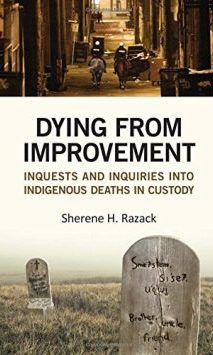On April 11, 2000 a supermarket employee in Williams Lake, B.C. called police after spotting a drunk passed out at a storefront picnic table. A constable arrived and threw the man, Paul Alphonse of the Williams Lake Indian Band, into a police vehicle. Hold that image for a moment: the hopeless drunk, a peevish clerk, an angry cop. It was a very ordinary incident
Except Alphonse was mysteriously dead in police custody within a week. He suffered broken ribs and had a purple bruise on his chest the size of a boot, Alphonse’s boot. The man could not have stomped himself to death. At the inquest, Constable Bob Irwin testified Alphonse was so violent he’d slapped him around and pinned him against a wall at police headquarters. None of this was corroborated by precinct video cameras. They weren’t operating that day.
Alphonse was 67, weighed 120 pounds, and had been arrested for drunkenness more than 70 times. He was a small, sick old man. Constable Irwin stood over 6’, weighed 240 pounds and enjoyed martial arts. “The pathologist believed the stomping had probably occurred just prior to Alphonse’s arrest and may not have been due to the actions of police,” writes Professor Sherene Razack, a sociologist at the University of Toronto’s Institute for Studies In Education. “There remained only the sinister possibility that someone deliberately stomped on Alphonse while wearing his own boot.”
Alphonse’s gravesite is shown on the cover of Dying From Improvement, a riveting examination of deaths in police custody in Canada. Professor Razack pored over testimony of coroners’ inquiries and identifies a disturbing them. For a disproportionate number of Indigenous men arrest is fatal. Razack counted 116 deaths in custody in Saskatchewan between 1995 and 2013 including suicides, shootings, “head injuries,” fatal run-downs by police cars and hypothermia.
The death of Neil Stonechild, 17, is recounted. In 1990 Stonechild was picked up after drinking and causing a ruckus at a Saskatoon 7-Eleven store. They found him frozen to death on the outskirts of town with wrist marks that looked like handcuffs. Two constables last seen with Stonechild were subsequently fired but no charges were ever laid. “Why is indigenous death nearly always a timely death, a death that no one could prevent or cause?” asks Razack.
Parliament abolished capital punishment in 1976. Yet public drunkenness is punishable by death under peculiar circumstances. Dying From Improvement is vivid and disturbing. Professor Razack draws readers with an electric narrative and police reporter’s eye for detail.
The images are indelible: The frozen boy, the mysterious bootprint, the last moments of Frank Paul, drunk on mouthwash and left to die after being dragged into a Vancouver alleyway by city police just before Christmas in 1998.
Police Sergeant Russell Sanderson, the officer who ordered that Paul be dragged away, was later suspended two days without pay: “Asked whether he agreed that his action with respect to Frank Paul was the biggest mistake of his career, Sanderson replied: ‘That’s a hard question. I don’t think I can really answer that question without a lot of deep thought and without going back over my career. There’s a lot of things I’ve done.’”
By Holly Doan
Dying From Improvement: Inquests & Inquiries Into Indigenous Deaths In Custody, by Sherene H. Razack; University of Toronto Press; 328 pages; ISBN 9781-4426-28915; $23






